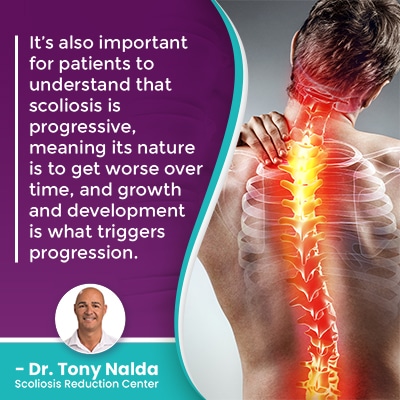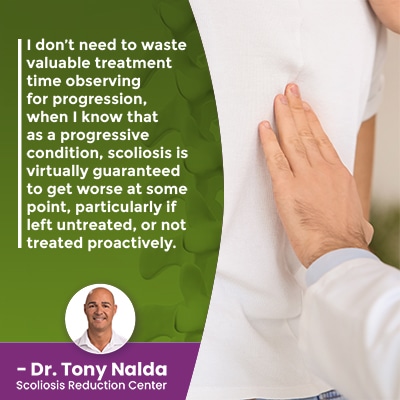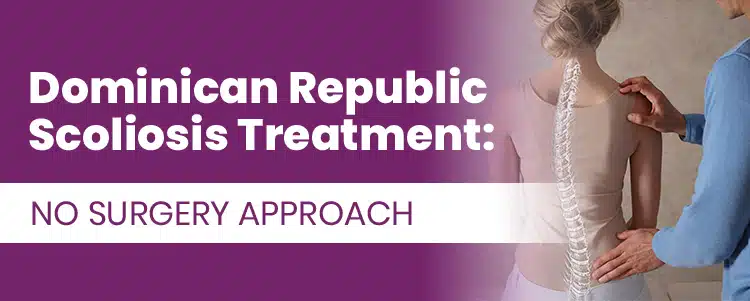When I diagnose a patient with scoliosis, I’m often met with a number of questions; they ask why it developed, how bad it will get, and how it should be treated moving forward. There is more than one way to treat scoliosis, but each offers patients a different potential outcome because of how it affects spinal health and function; continue reading to learn more about the different scoliosis treatment approaches.
Not all parts of the world can access the same level of scoliosis treatment. For residents of the Dominican Republic, an approximate 2.5-hour flight over 947 miles puts them within reach of an industry-leading non-surgical scoliosis treatment center: Dr. Tony Nalda’s Scoliosis Reduction Center®.
As a person’s journey with scoliosis starts with a diagnosis, let’s start with how a diagnosis is reached.
How is Scoliosis Diagnosed?
The spine’s natural curves make it appear straight when viewed from the front and/or back, and give it a soft ‘S’ shape when viewed from either side.
These healthy spinal curves allow for the spine to have a wide range of motion, be strong, and facilitate its even distribution and absorption of mechanical stress incurred during activity.
If the spine loses a healthy curve, it doesn’t just affect that one area of the spine; it disrupts the biomechanics and health of the entire spine.
When the spine’s natural and healthy curves are in place, its vertebrae (bones of the spine) are aligned as they should be, but if there is a loss of the spine’s healthy curves, some vertebral bodies have become unnaturally tilted, shifting them out of alignment with the rest of the spine.
Scoliosis is the development of an unnatural sideways spinal curve that also rotates, meaning it twists, and the rotation makes scoliosis a 3-dimensional condition.
In addition, in order to be considered a true scoliosis, it has to be of a minimum size: Cobb angle measurement of at least 10 degrees.
A patient’s Cobb angle is determined during X-ray by drawing lines from the tops and bottoms of the curve’s most-tilted vertebrae, at its apex, and the intersecting angle is expressed in degrees.
The higher a patient’s Cobb angle, the more severe the condition, and the further out of alignment the spine is:
- Mild scoliosis: Cobb angle measurement of between 10 and 25 degrees
- Moderate scoliosis: Cobb angle measurement of between 25 and 40 degrees
- Severe scoliosis: Cobb angle measurement of 40+ degrees
- Very-severe scoliosis: Cobb angle measurement of 80+ degrees

It’s also important for patients to understand that scoliosis is progressive, meaning its nature is to get worse over time, and growth and development is what triggers progression.
So scoliosis is diagnosed through a physical examination, during which I take the patient’s family and medical history, observe the patient’s posture and gait, and perform an Adam’s forward bend test.
If condition indicators are present, I order an X-ray so I can fully see what’s happening in and around the spine, and if a scoliotic curve of at least 10 degrees is present, a diagnosis of scoliosis is reached, and now it’s time to decide how to treat it.
Scoliosis Treatment Options
When it comes time to decide how to treat scoliosis, I want patients, and their families, to be aware that there is more than one way to treat scoliosis, and many cases of scoliosis don’t require surgery.
Traditional scoliosis treatment offers a surgical response, after merely observing conditions while mild and waiting for them to progress into the severe classification, at which point patients become surgical candidates.
Traditional treatment does often attempt bracing when moderate, but traditional bracing doesn’t address the condition’s true 3-dimensional nature so is limited in its potential efficacy.
Spinal fusion involves fusing the curve’s most-tilted vertebrae into one solid bone and often attached rods to the spine with screws to hold it in place, but spinal fusion surgery comes with some heavy potential risks, side effects, and can negatively affect the spine’s natural strength, flexibility, and function.
Fortunately, for those wanting to forgo a surgical recommendation or try a more-natural type of treatment first, the Scoliosis Reduction Center® offers patients another treatment option: a no surgery approach.
Non-Surgical Scoliosis Treatment
Those looking for a no surgery approach to treating scoliosis in the Dominican Republic can be limited in the types of treatment available, but a 2.5 hour flight to Celebration, Orlanda, Florida can put them within reach of Dr. Tony’s impressive Center results.
In addition, those making the trip to Orlando for a consult and/or scoliosis treatment can also take in the Sunshine state’s many attractions: Disney World, Universal Studios, SeaWorld, and so much more.
Here at the Center, my main treatment goal is to reduce the size of the scoliotic curve on a structural level, and I work towards this by being proactive and starting treatment as close to the time of diagnosis as possible.

I don’t need to waste valuable treatment time observing for progression, when I know that as a progressive condition, scoliosis is virtually guaranteed to get worse at some point, particularly if left untreated, or not treated proactively.
So those looking for Santo Domingo scoliosis treatment, Puerto Plata scoliosis treatment, La Vega, etc, residents of the Dominican Republic don’t have as far to travel as many who make the journey to Orlando in search of effective non-surgical scoliosis treatment.
Through condition-specific chiropractic care, physical therapy, corrective bracing, and rehabilitation, I can impact conditions on every level and help patients manage their progression while avoiding the need for invasive spinal surgery.
Conclusion
Dominican Republic scoliosis treatment doesn’t just have to include what that country has to offer; with a 2.5 hour flight, residents can access non-surgical scoliosis treatment provided by one of the world’s leading scoliosis chiropractors: Dr. Tony Nalda of the Scoliosis Reduction Center®.
For over 20 years, the Center’s impressive results have been supporting the belief that surgery is neither the best, nor only scoliosis treatment option available.
As a progressive condition, scoliosis has it in its nature to worsen over time, which is why being proactive with treatment is so important.
Conservative scoliosis treatment is a no surgery approach, and for those who live in parts of the world with less access to a variety of scoliosis treatment options, making the choice to travel for potentially-effective non-surgical treatment can benefit patients in a number of ways.
So don’t hesitate to contact us for more guidance and support; it can be the first step on the road to effectively managing and treating scoliosis.




